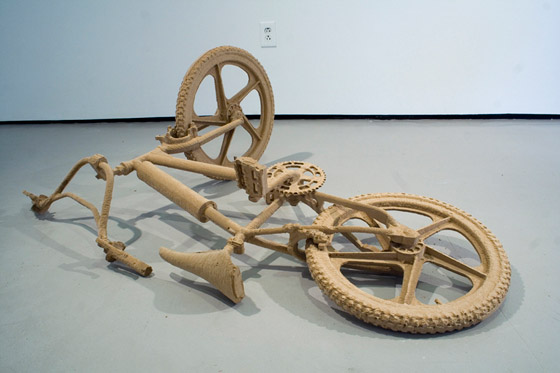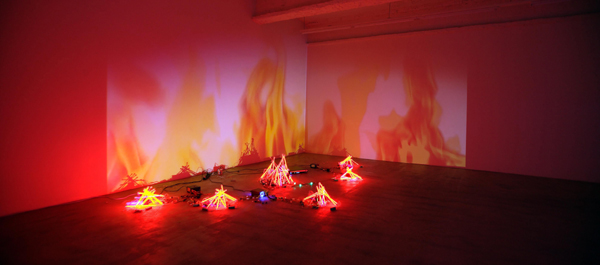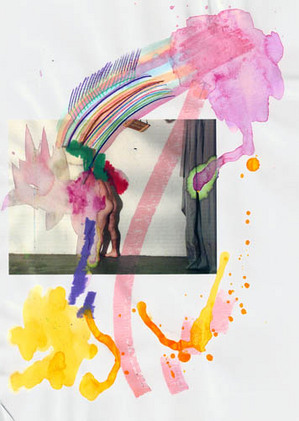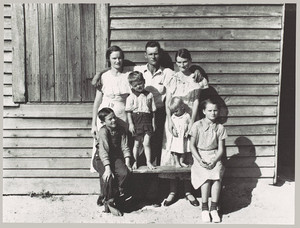This is an archive of the ArtCat Zine, 2007-2009. Please visit our new project, IDIOM.
Recently by Susannah Edelbaum

At NURTUREart’s exhibition for the Bushwick Biennial, the intent is to focus on “utopia, urban change, and the role of a place in artistic identity” but the resulting show is dreamier and niftier than those themes might imply. Entering the gallery made me imagine walking into a human-sized, contemporary version of one of Joseph Cornell’s boxed assemblages.
Going upstairs to the show is a gradual, gentle process, beginning with the trailer parked outside the building, which houses a garden complete with a pond and love-seat length bench (there is a tiny, even cuter prototype of Kim Holleman’s work, Trailer Park, in the gallery itself.) The show is sandwiched by gentle, repetitive pieces – the stairs leading to the space play host to Escalator Helix Vertical, an animated illustration of spinning escalators, and the gallery’s adjacent rooftop is covered with Audrey Hasen Russell’s Beam Tower with Pink Grass, which is what its name implies – coils and coils of cotton-candy-colored pink foam which have been cut into spiky forms to look like grass.
I really liked this show, though I expected not to. My last experience with earnest-seeming art in Bushwick was…I can’t remember when. I may have never seen it before. Benjamin Evans, who curated the show for NURTUREart, has done an incredible job of putting together something appealing, and sometimes even cute (be sure to see The Farthest City, by James Reeder – it’s a charming wall-mounted utopia) that still maintains a sense of humor and a healthy sense of dignity. A perfect example is Fallen, Jonathan Brand’s prone fiberboard bicycle. The life-sized, super-accurate apparatus lies on the gallery floor in front of three petite drawings depicting a biker in various stages, the last of which shows him on the ground next to his similarly horizontal bicycle. The drawings are sweet, and they’re funny, and they’re good. Please go see this show. Its so nice to encounter work that is simultaneously compelling and funny.
Kitten
Andres Laracuente, Matthew Lutz-Kinoy and
John Patrick Walsh
Jane Kim / Thrust Projects -
114 Bowery #301, New York NY
16 January - 22 February 2009
It’s funny, and maybe telling, that Thrust Projects is a short walk down the Bowery from The New Museum. Thrust’s current exhibit, Kitten, has the earmarks of recent New Museum shows – a precise mix of media and somber colors within varied types of work, and an equally precise subsequent placement of those works.
Kitten particularly recollects Unmonumental: The Object in the 21st Century, an exhibition that marked the opening of the New Museum’s Lower East Side location. The two exhibitions, while very different in scope and ambition, share an emphasis on the curious, the found, the discarded and the repurposed. A series of objects – a double-headed cane, two paddles of the whacking variety rather than the boating, etc. – are carefully lined up against one wall of the gallery at Thrust. The piece, Disciplines Disciples, by John Patrick Walsh, reminded me of Abraham Cruzvillegas's Canon enigmatico a 108 voces from Unmonumental. Beyond the formal similarities the two seem to operate with a similar logic, to work in a similar spirit.
Comparing a three-person group show to something as ambitious as Unmonumental is of course unfair. However, this distinction between the two is what makes Kitten notable – the exhibition and the venue are mutually appropriate. Exhibitions like this one, filled as they are with often unbeautiful oddities, sometimes come across as displeasing, inaccessible, or at worst, pointless. However, in no way does a single show discredit the individual works exhibited. It becomes then all the more necessary to show the right work in the right way. Kitten, organized by artists Andres Laracuente, Matthew Lutz-Kinoy and John Patrick Walsh (along with guests dropping by to do accompanying performances which have marked Kitten’s tenure) is a model for artist-organized exhibitions of sculpture and mixed media works.
Thrust Projects is housed in an intimate space, whereas the ratio of the grand scale of the New Museum’s galleries to the curios contained within made Unmonumental unecessarily hard. (Humorously, many opined last year of the New Museum's relative lack of space when compared to New York's other major museums of contemporary art.) The difference is like seeing a macau in a petting zoo instead of the jungle. It’s just easier to get a thorough look at the petting zoo.
Works like those at Kitten require a good close-up, particularly not to miss their humor. The down-the-rabbit-hole approach to art making works the best when it’s funny, and Smoking pipes with shoes by Walsh at Kitten is a fine example of that. The piece features two exhaust pipes with an old pair of men’s shoes sitting on top. While I looked around, the gallerist lit two sticks of opium incense that were poking out the pipes. The piece looked ready for takeoff, like a modern-day witch’s conveyance. Sub in incense twigs for the branches of a broom, and it was ready to go.

From Another Shore: Recent Icelandic Art
May 1 - August 15, 2008
Scandinavia House - 58 Park Avenue
Initially, the most noticeable works at the gallery at Scandinavia House are the pieces comprising Haul. Five tiny models scattered around the floor envision lightly populated landscapes; viewed from above, the sculptures give visitors the effect of the ground viewed from an airplane window. Referencing the artist’s own tendency to move around the world, the landscapes are built within cargo crates sized to fit them; the crates themselves look haphazardly opened and ready to be packed back up at any moment. Their creator, Katrín Sigurðardóttir, is from Iceland, as are all the artists featured in From Another Shore – studies have brought her to San Francisco and New Jersey, and in that way she exemplifies a part of the premise behind the organization of the show.
Archive Fever - Uses of the Document in Contemporary Art
8 January 2008 - 4 May 2008
International Center for Photography Museum - 1133 Avenue of the Americas New York, NY
Archives are a ubiquitous institution, but the significance of an archive threatened by war is an entirely different animal — in its new and tenuous position, it changes drastically in terms of size and form. Archive Fever – Uses of the Document in Contemporary Art, at the International Center of Photography, explores and exposes as many aspects, structures, and uses of archiving as can be explored and exposed, and at the same time seems to have reserved, wisely, a little extra space for photographs, videos, and projects born of/predicated on human strife. It is an incredibly unfrivolous show.
Although an exhibit that particularly wants to translate historical events from the 1960s to the present is bound to become caught up in the sadder episodes of those years, the curator, Okwui Enwezor, folds them into Archive Fever so that, more than anything else, they make sense. Where a series of photographs of terrorists’ relatives’ hands could have awkwardly glared at its viewers, the pictures’ purpose is well-exercised within the form of the show. Looking around, and equally importantly, reading the accompanying text to each exhibit, bestows a very present feeling that this show has been quite actively assembled.
What Enwezor has created is a web of references to and reenactments of revolutions, civil wars, segregation and deprivation. These solemn pieces are spread among works like Christian Boltanski’s stacked, dimly lit boxes labeled with black and white photos (evoking a conventional view of an archive) and Glenn Ligon’s room full of Robert Mapplethorpe’s black and white pictures of nude black men (re-archiving another archive, and bringing to light myriad questions regarding the validity and nature of the photographs themselves.) Ligon’s piece is spangled with commentary from myriad sources, and through this conceit becomes archetypical of the show – it depicts archiving for the sake of archiving. More importantly, however, from its heightened awareness of what it means for an archive to fill the roll it does, Notes on the Margin of the Black Book, like Archive Fever as a whole, appears intelligently in earnest about the significance of its own subject matter.
ZINE
HOME
TIPS / COMMENTS
CATEGORIES
CONTRIBUTORS
- Greg Afinogenov
- B. Blagojevic
- Adda Birnir
- Susannah Edelbaum
- Julie Fishkin
- Paddy Johnson
- Jessica Loudis
- Christopher Reiger
- Andrew Robinson
- Peter J. Russo
- Blythe Sheldon
- S.C.Squibb
- Hrag Vartanian


